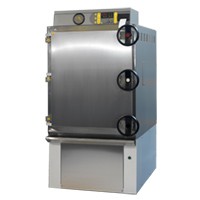Members Login

Channels
Special Offers & Promotions
Priorclave Autoclave Saves University Thousands
 Change from a 350 litre Power-Door autoclave to a Priorclave 450 litre laboratory autoclave installed in the ‘plant’ research laboratory of York University’s Biology Department has strengthened its green credentials, slashing significantly energy costs associated with running a sterilisation process for compost and vegetation with a massive 90% reduction in water usage.
Change from a 350 litre Power-Door autoclave to a Priorclave 450 litre laboratory autoclave installed in the ‘plant’ research laboratory of York University’s Biology Department has strengthened its green credentials, slashing significantly energy costs associated with running a sterilisation process for compost and vegetation with a massive 90% reduction in water usage.
Coupled with other benefits the font loading autoclave has given the department a very economical sterilisation capability. Owing to the nature of the research work undertaken, this area of the University is classified as a Containment Level 1, only those with authorisation can gain access to the laboratory. In order to maintain the highest level of decontamination risk-potential, after experimental procedures involving seed and GM investigation, all waste is carefully sterilised for safe disposal using steam autoclaves.
Energy and Space Saving
Since installing the Priorclave front loading autoclave, model SH450, side by side analysis of running costs between the new ‘self-contained’ autoclave and the original power-door model fed with steam via the external generator showed an overall saving of 56%. The major contribution to this massive saving is associated with cost of water supply and disposal, amounting to a reduction of 88% and 89% respectively. Since the University is in a hard-water area Priorclave also recommended fitting of a water softener, this resulted again in a very big reduction of salt requirements – a 92% cut compared to the previous operation.
The power-door autoclave, although only a 350 litre machine had a much larger footprint than the Priorclave autoclave and required a separately housed 45kW generator that ran constantly 24/7 to provide the required level of steam for sterilisation.
Since the new autoclave has an inbuilt generator which heats water on demand, costs are cut significantly. Sterilisation takes place two to three times a day, five days a week, by heating water-on-demand it is estimated to save the University £7.58 per run; potential energy cost-saving of nearly £6,000 pa.
When York University’s Biology Department made the change to the Priorclave autoclave the laboratory acquired a machine with a larger capacity (450 litres) but with a smaller footprint, creating more free-space within the actual laboratory as well as totally freeing up a room, which previously housed the generator.
The challenge of maintaining high product quality while reducing production costs can be met through investments in energy-efficient technologies and energy-efficiency practices. Also prudent purchasing can help balance the books, more recently however, ‘cost of ownership’, particularly that of plug-load equipment such a laboratory autoclave has come under scrutiny more than ever before.
Looking at and investing in new technologically advanced systems is not sufficient, organisations need to examine how equipment is actually used. Utility costs rarely stay constant; normally they follow an upward trend which makes it even more important to examine the day-today running costs. Companies need to look inwardly as to whether there are ways to use less energy - electricity, gas, and water — whether from a dutiful sense of environmental preservation or simply to save money, or both.
By reviewing its actual sterilisation requirements this major research York University achieved a signification reduction in direct energy costs and a massive overall savings of 56%.
Media Partners


